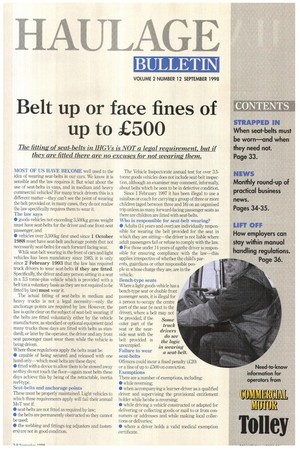HAULAGE
Page 35

If you've noticed an error in this article please click here to report it so we can fix it.
BULLETIN
VOLUME 2 NUMBER 12 SEPTEMBER 1998
Belt up or face fines of up to £500
The fitting of seat-belts in lHGVs is NOT a legal requirement, but if they are fitted there are no excuses for not wearing them.
MOST OF US HAVE BECOME well used to the idea of wearing seat-belts in our cars. We know it is sensible and the law requires it. But what about the use of seat-belts in vans, and in medium and heavy commercial vehicles? For many truck drivers this is a different matter—they can't see the point of wearing the belt provided or, in many cases, they do not realise the law specifically requires them to wear it.
The law says • goods vehicles not exceeding 3,500kg gross weight must have seat-belts for the driver and one front-seat passenger; and
• vehicles over 3,500kg first used since 1 October 1988 must have seat-belt anchorage points (but not necessarily seat-belts) for each forward facing seat.
While seat-belt wearing in the front of cars and light vehicles has been mandatory since 1983, it is only since 2 February 1993 that the law has required truck drivers to wear seat-belts if they are fitted. Specifically, the driver and any person sitting in a seat in a 3.5 tonne-plus vehicle which is provided with a belt (on a voluntary basis as they are not required to be fitted by law) must wear it
The actual fitting of seat-belts in medium and heavy trucks is not a legal necessity—only the anchorage points are required by law. However, the law is quite clear on the subject of seat-belt wearing; if the belts are fitted voluntarily either by the vehicle manufacturer, as standard or optional equipment (and many trucks these days are fitted with belts as standard), or later by the operator, the driver and any front seat passenger must wear them while the vehicle is being driven.
Where these regulations apply the belts must be: • capable of being secured and released with one hand only—which most belts are these days; • fitted with a device to allow them to be stowed away so they do not touch the floor—again most belts these days achieve this by being of the retractable, inertia reel-type.
Seat-belts and anchorage points These must be properly maintained. Light vehicles to which these requirements apply will fail their annual MoT test if: • seat-belts are not fitted as required by law, • the belts are permanently obstructed so they cannot be used • the webbing and fittings (eg adjusters and fasteners) are not in good condition. The Vehicle Inspectorate annual test for over 3.5tonne goods vehicles does not include seat-belt inspection, although an examiner may comment, informally, about belts which he sees to be in defective condition.
Since 1 February 1997 it has been illegal to use a minibus or coach for carrying a group of three or more children (aged between three and 16) on an organised trip unless as many forward-facing passenger seats as there are children are fitted with seat-belts.
Who is responsible for seat-belt wearing?
• Adults (14 years and over) are individually responsible for wearing the belt provided for the seat in which they are sitting—the driver is not liable where adult passengers fail or refuse to comply with the law.
• For those under 14 years of agethe driver is responsible for ensuring compliance with the law—this applies irrespective of whether the child's parents, guardians or other responsible people in whose charge they are, are in the vehicle.
Bench-type seats Where a light goods vehicle has a bench-type seat or double front passenger seats, it is illegal for a person to occupy the centre part of the seat (IC next to the driver), where a belt may not be provided, if the outer part of the seat or the nearside seat with the belt provided is unoccupied. Failure to wear seat-belts Offences could incur a fixed penalty (00) or a fine of up to £500 on conviction. Exemptions There are a number of exemptions, including • while reversing; • when accompanying a learner-driver as a qualified driver and supervising the provisional entitlement holder while he/she is reversing • while driving a vehicle constructed or adapted for delivering or collecting goods or mail to or from consumers or addresses and while making local collections or deliveries;
Some truck drivers do see the logic in wearing a seat-belt.












































































































